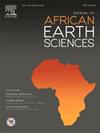Structural architecture and metamorphism of the Mayombe Chain and Niari Basin (West Congo Belt) in Congo Brazzaville
IF 2.2
4区 地球科学
Q2 GEOSCIENCES, MULTIDISCIPLINARY
引用次数: 0
Abstract
Geological mapping of the Mayombe Chain and Niari Basin of Congo Brazzaville allows for the first time defining the structural architecture and metamorphism of the West Congo Belt. Four different tectono-metamorphic domains, separated by crustal-scale shear zones, are now distinguished (Niari Basin (NB), Eastern (EMC), Central (CMC) and Western (WMC) Mayombe Chain).
The NB is marked by only weak regional deformation under middle to upper diagenetic conditions. It is delimited in the west from the EMC by the Mount Belo Shear Zone forming the terminal thrust system of the West Congo orogen.
The tectonic style in the EMC is characterized by discrete, widely-spaced low-angle thrusts, reverse faults and strike-slip faults resulting in the formation of duplex and/or positive flower structures. Off these high-strain zones, the rocks are folded into gentle syn- and anticlines. Penetrative schistosity starts in shales in the western part. The metamorphism increases from eastern anchizonal conditions to lower greenschist facies in the west. The EMC is juxtaposed along the Moukondo thrust/back-thrust system with the CMC.
The CMC is typified by open to closed upright to NE-verging folds, S1 schistosity with moderate to steep SW dips, onset of regional crenulation cleavage (S2), frequent reverse thrusts and numerous faults. Metamorphic conditions remain in the greenschist facies. The Loukenéné-Mandji Thrust marks the CMC-WMC contact and coincides with a jump in metamorphic grade marked by biotite-in.
The WMC consists of Palaeoproterozoic basement stacked with Neoproterozoic rocks. Autochthonous Palaeoproterozoic gneiss and schist record Late Eburnean sedimentation, magmatism and metamorphism between 2110 and 1970 Ma, which are compared with the Eburnean history in Gabon and the Transamazonian orogeny in Brazil. The allochthonous Bikossi Group was thrust during the Pan-African event from the west over Tonian metavolcaniclastic and plutonic rocks before further folding and stacking of both units. The intensity of Pan-African deformation increases from open to closed folds with spaced cleavage in the southeast of the WMC to thrust-dominated tectonics in the northwest, where the Palaeo- and Neoproterozoic rocks are transposed into parallelism with the pronounced schistosity.
Geochronology of illite and muscovite documents two Pan-African events at 590-570 Ma (M1) and at 520-500 Ma (M2) that are related to the main collisional and late thermal events in the Araçuai-Ribeira Belt in Brazil. Metamorphic isogrades shifted from M1 to M2 for more than 30 km to the west. Detrital mica and metamorphic illite of the Mpioka Group record M1 and M2, respectively constraining sedimentary deposition between 570 and 520 Ma, which implies the interpretation of the group as molasse of the West Congo Belt.
刚果(布)马永贝链和尼亚里盆地(西刚果带)的结构构造和变质作用
通过对刚果(布)马永贝链和尼亚里盆地进行地质测绘,首次确定了西刚果带的构造结构和变质作用。由地壳尺度剪切带分隔的四个不同的构造-变质域现已被区分开来(尼阿里盆地(Niari Basin,NB)、东部马永贝链(Eastern Mayombe Chain,EMC)、中部马永贝链(Central Mayombe Chain,CMC)和西部马永贝链(Western Mayombe Chain,WMC))。其西部与 EMC 的分界线是贝洛山剪切带,该剪切带形成了西刚果造山带的末端推力系统。EMC 的构造风格以离散、大间距的低角度推力、逆断层和走向滑动断层为特征,从而形成了双重和/或正花构造。在这些高应变带之外,岩石被褶皱成平缓的同向和反向构造。西部的页岩中开始出现穿透性片岩。变质作用从东部的锚状条件向西部的低绿泥石面发展。CMC的典型特征是开放至封闭的直立至东北向褶皱、具有适度至陡峭西南倾角的S1片岩、开始出现区域性细圆劈理(S2)、频繁的反向推力和众多断层。变质条件仍为绿岩面。Loukenéné-Mandji推断带标志着CMC-WMC接触面,并与以生物玢岩为标志的变质阶跃相吻合。自生的古新生代片麻岩和片岩记录了 2110 至 1970 Ma 之间的晚埃伯尼期沉积、岩浆作用和变质作用,并与加蓬的埃伯尼期历史和巴西的 Transamazonian 造山运动进行了比较。在泛非事件期间,同源的比科西组从西面推覆在托尼安元火山碎屑岩和深成岩之上,然后这两个单元进一步褶皱和堆积。泛非大地构造的强度从水磨沟区东南部的开放式褶皱到闭合式褶皱,再到西北部以推覆构造为主的褶皱,古生代和新近古生代岩石在这里被转置为平行构造,并出现了明显的片理。伊利石和白云母的地质年代学记录了两个泛非事件,分别发生在 590-570 Ma(M1)和 520-500 Ma(M2),与巴西阿拉苏艾-里贝拉带的主要碰撞和晚期热事件有关。变质等级数从 M1 向西移动了 30 多公里到达 M2。姆皮奥卡组的云母和变质伊利石分别记录了 M1 和 M2,从而确定了 570 至 520 Ma 之间的沉积沉积,这意味着该组被解释为西刚果带的熔岩。
本文章由计算机程序翻译,如有差异,请以英文原文为准。
求助全文
约1分钟内获得全文
求助全文
来源期刊

Journal of African Earth Sciences
地学-地球科学综合
CiteScore
4.70
自引率
4.30%
发文量
240
审稿时长
12 months
期刊介绍:
The Journal of African Earth Sciences sees itself as the prime geological journal for all aspects of the Earth Sciences about the African plate. Papers dealing with peripheral areas are welcome if they demonstrate a tight link with Africa.
The Journal publishes high quality, peer-reviewed scientific papers. It is devoted primarily to research papers but short communications relating to new developments of broad interest, reviews and book reviews will also be considered. Papers must have international appeal and should present work of more regional than local significance and dealing with well identified and justified scientific questions. Specialised technical papers, analytical or exploration reports must be avoided. Papers on applied geology should preferably be linked to such core disciplines and must be addressed to a more general geoscientific audience.
 求助内容:
求助内容: 应助结果提醒方式:
应助结果提醒方式:


